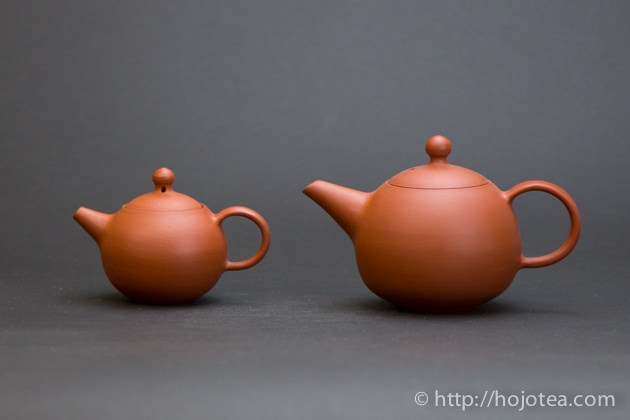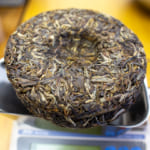- HOME >
- How to enjoy tea
Cooling speed of water differs depending on the volume of teapot
- [2018.01.23] Posted By Akira Hojo
The smaller the size of teapot the faster the temperature it cools down
Some people tends to use a small teapot to brew tea, and assumed that smaller teapot can hold the temperature. The fact is the smaller the teapot, the the faster the temperature drops. It is because of the ratio between the inner surface area and the volume of water. The specific surface area becomes smaller when the volume of teapot is bigger. On the contrary, the smaller the teapot, the more specific surface area. As a result, more water exchanges its heat energy with the surface of clay and it cools down water faster. After all, the smaller the teapot, the faster it cools down. Relatively, the big teapot can hold the temperature for a longer time.
Brewing Japanese green tea
In general, the brewing temperature of Japanese green tea is recommended at below 80 degree C. It is because most of Japanese green teas are grown with fertilizer which makes the taste of tea very bitter. The bitterness comes from caffeine. The caffeine will be effectively extracted with hot water above 80 degree C. So, if we brew tea at below 80 degree C, you can avoid or minimize the bitterness.
On the other hand, some Japanese green teas grown without fertilizer originally give the least bitter taste. So, it is not necessary to brew it at lower temperature. On the contrary, it is very important to brew these teas at higher temperature in order to effectively extract the flavor substance, reduce the astringency and enjoy a clean and clear drinking sensation.
A big teapot is suitable for a beginner.
Brewing tea at high temperature is not that easy as how it sounds. It requires various brewing skills, such as pre-heating of teapot and rinsing tea with boiling water. In most of the cases, a beginner might face greater challenges to brew tea at high temperature. Considering this fact, we recommend the beginner to use a bigger teapot. As I mentioned earlier, a big teapot retains the heat for a longer time. Even if one does not have a good skill of brewing, it is less difficult to maintain it at very high temperature throughout the brewing. Of course, a small teapot is also a useful equipment as long as it is handled with skills.
https://hojotea.com/jp/posts-1029/
Measurement of water temperature in different size of teapot
The above video was made based on three different sizes of teapot. These teapots are made from exactly the same clay (i.e., the Akitsu Mumyoi Oxidation Fired Teapot). I poured boiling water into three teapots and left for a minute. The volume is 100ml (right), 140ml (middle) and 300ml (left). We noticed that there was 6 degree C of difference. These teapots are not pre-heated.
100ml 79℃
140ml 83℃
300ml 85℃
The room temperature was at around 25 degree C. If we conduct the same experiment in a colder room, the difference will be more. If the teapot with the volume of 100ml is not pre-heated, the temperature reduced around 20 degree C. The temperature inside the teapot is much lower than what we imagine.
PS: Additional Note
I tried the same experiment when teapots were pre-heated. I used 2 teapots, the smallest one and the biggest one. They were pre-heated for 10 seconds with boiling water once and twice respectively. The temp was measured after 1 minute. With one time pre-heating, the small one was at 81.5 degree C, while the big one was at 89 degree C. With double pre-heating, the small one was at 89 degree C, while the big one was at 91 degree C. It looks like we need an extensive pre-heating when we use a small teapot.
Related Articles
How to get the latest update on HOJO?
1. Follow Twitter, 2. Click "Like" on Facebook, and 3. Subscribe in newsletter. You can have the latest tea news from HOJO.
 Subscribe the Newsletter to enjoy the privileges
Subscribe the Newsletter to enjoy the privileges- You may receive a free sample upon purchase, or you may have the priority to purchase special products. So please remember to subscribe our newsletter as well as the social network.
- New Arrival of Akitsu Mumyoi and Nosaka Rough Clay Teapot
- A wide selection of teaware by Watanabe Tozo, a Sado-based artist of Mumyoi-yaki, has just arrived. This time, …
- Mang Fei Ripe Pu-erh Tea 2023 – Small-Batch Production from a Renowned Region
- Mang Fei Ripe Pu-erh Tea 2023 is now available. This is one of the highest-quality ripe pu-erh teas among our …
NEW ARTICLES
 Development of Firewood Roasted Hojicha Using Naturally Grown Tea from Yunnan
Development of Firewood Roasted Hojicha Using Naturally Grown Tea from Yunnan- We are currently staying in Yunnan Province for tea production. As the season nears its end, tea trees with pa …
 Exploring the Food Culture of Yunnan: Where Minority and Sichuan Cuisines Meet
Exploring the Food Culture of Yunnan: Where Minority and Sichuan Cuisines Meet- We are currently staying long-term in Yunnan Province for spring tea production. On rainy days or when there i …
 New Arrival of Akitsu Mumyoi and Nosaka Rough Clay Teapot
New Arrival of Akitsu Mumyoi and Nosaka Rough Clay Teapot- A wide selection of teaware by Watanabe Tozo, a Sado-based artist of Mumyoi-yaki, has just arrived. This time, …
 Managing Yunnan White Tea — Insights from the Field
Managing Yunnan White Tea — Insights from the Field- Since March 25, we have been in Yunnan Province, fully engaged in the production of white tea. In this column, …
 Mang Fei Ripe Pu-erh Tea 2023 – Small-Batch Production from a Renowned Region
Mang Fei Ripe Pu-erh Tea 2023 – Small-Batch Production from a Renowned Region- Mang Fei Ripe Pu-erh Tea 2023 is now available. This is one of the highest-quality ripe pu-erh teas among our …
 Yunnan Tea Trends 2025: Insights from the Fields
Yunnan Tea Trends 2025: Insights from the Fields- Since March 25, we have been in Yunnan Province. We will stay here until May to conduct tea production, packin …
 Why Do Some Teas Taste Astringent? Exploring the Causes and Mechanisms of Astringency
Why Do Some Teas Taste Astringent? Exploring the Causes and Mechanisms of Astringency- Tea can range from having no noticeable astringency to possessing a very strong one. What causes this astringe …
 The Impact of Heat Sources on Tea Flavor
The Impact of Heat Sources on Tea Flavor- It is widely recognized that the material of a kettle plays an important role in shaping the taste of water fo …
 New Release of Tang Li Shan Ripe Pu-erh Tea 2023
New Release of Tang Li Shan Ripe Pu-erh Tea 2023- We have released the 2023 edition of Tang Li Shan Ripe Pu-erh Tea. Tang Li Shan refers to a mountain located o …
 The New Release of Dong Shan Raw Pu-erh Tea 2023 and Jasmine Silver Needle
The New Release of Dong Shan Raw Pu-erh Tea 2023 and Jasmine Silver Needle- We have released Dong Shan Raw Pu-erh Tea 2023 and Jasmine Silver Needle. Dong Shan Raw Pu-erh Tea 2023 We hav …
Category
- New Arrival at HOJO Online Shop
- Featured Articles
- Newsletter
- Types of Tea
- Origin of Tea
- Teapot and Tea Equipment
- Tea Column
- How to enjoy tea
- Tea Processing
- How to choose quality tea
- Tea constituents and functional effect
- Safety of Tea
- Foods
- Tea Business Operation
- Hobby and Outdoor Activity
- Ranking of Tea
- Video
- FAQ
- Media Release
Profile

- AKIRA HOJO
- I invite you to experience my tea selections.I was born in Nagano, Japan. In university, I studied agricultural chemistry, and I have the master degree in food science. I worked in Japanese food industry for 10 years. I involved in R&D, QC and QA. As a factory manager, I implemented ISO9000 series and managed the factory.
- The Art of Tea Magazine
- We posted the article on “The Art of Tea Magazine No.9, the magazine is published in Taiwan. We featured …
- New Straits Times
- The Malaysian National Newspaper, New Straits Times featured HOJO Tea on 17-Oct-2007.
Shop Info

Address:Lot No. T-215, 3rd Floor, The Gardens Mall, Mid Valley City, Lingkaran Syed Putra, 59200 Kuala Lumpur
Tel: +603-2287-4537
Business Hour: 10am to 10pm















